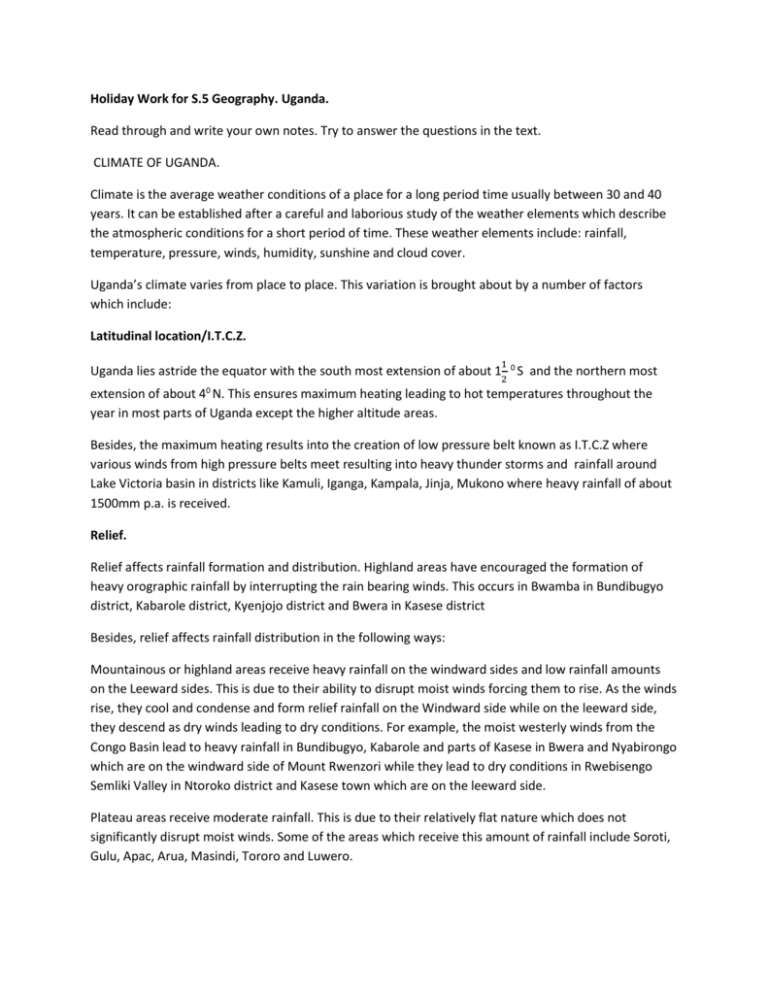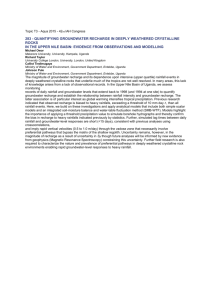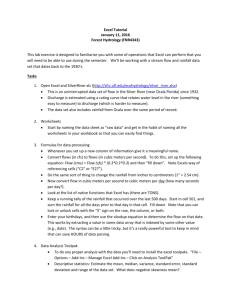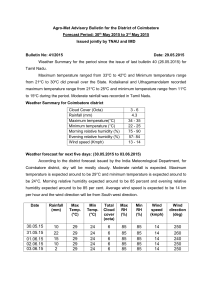Uganda. Climate. - Grace High School
advertisement

Holiday Work for S.5 Geography. Uganda. Read through and write your own notes. Try to answer the questions in the text. CLIMATE OF UGANDA. Climate is the average weather conditions of a place for a long period time usually between 30 and 40 years. It can be established after a careful and laborious study of the weather elements which describe the atmospheric conditions for a short period of time. These weather elements include: rainfall, temperature, pressure, winds, humidity, sunshine and cloud cover. Uganda’s climate varies from place to place. This variation is brought about by a number of factors which include: Latitudinal location/I.T.C.Z. 1 Uganda lies astride the equator with the south most extension of about 12 0 S and the northern most extension of about 40 N. This ensures maximum heating leading to hot temperatures throughout the year in most parts of Uganda except the higher altitude areas. Besides, the maximum heating results into the creation of low pressure belt known as I.T.C.Z where various winds from high pressure belts meet resulting into heavy thunder storms and rainfall around Lake Victoria basin in districts like Kamuli, Iganga, Kampala, Jinja, Mukono where heavy rainfall of about 1500mm p.a. is received. Relief. Relief affects rainfall formation and distribution. Highland areas have encouraged the formation of heavy orographic rainfall by interrupting the rain bearing winds. This occurs in Bwamba in Bundibugyo district, Kabarole district, Kyenjojo district and Bwera in Kasese district Besides, relief affects rainfall distribution in the following ways: Mountainous or highland areas receive heavy rainfall on the windward sides and low rainfall amounts on the Leeward sides. This is due to their ability to disrupt moist winds forcing them to rise. As the winds rise, they cool and condense and form relief rainfall on the Windward side while on the leeward side, they descend as dry winds leading to dry conditions. For example, the moist westerly winds from the Congo Basin lead to heavy rainfall in Bundibugyo, Kabarole and parts of Kasese in Bwera and Nyabirongo which are on the windward side of Mount Rwenzori while they lead to dry conditions in Rwebisengo Semliki Valley in Ntoroko district and Kasese town which are on the leeward side. Plateau areas receive moderate rainfall. This is due to their relatively flat nature which does not significantly disrupt moist winds. Some of the areas which receive this amount of rainfall include Soroti, Gulu, Apac, Arua, Masindi, Tororo and Luwero. Lowlands, especially the Rift valley floor have a general absence of highlands to trap winds and therefore, receive low rainfall amounts. Such areas include: Butiaba, Buliisa, Ntoroko and parts of Kasese. Water bodies (Drainage) Regions near water bodies with large surface areas receive heavy rainfall of 1500mm and above due to the high evaporation levels resulting into convectional rainfall. They also experience lake and land breezes which lead to heavy rainfall and moderate the temperatures of the surrounding areas. Areas in Kampala, Wakiso, Entebbe, Jinja and Iganga which are near Lake Victoria, experience such conditions. While, regions with no or small water bodies like it is in Kiruhura, Sambabule and Lyantonde in the Ankole Masaka Corridor; Moroto, Kotido, Abim and Kaabong in Karamoja, receive low rainfall amounts and very hot temperatures due to low evaporation rates and absence of the lake and land breezes that would moderate the temperatures Activity. Using relevant sources in your school Library do more research on the land and lake breezes in Uganda. Then make your own notes by explaining the causes and effects of the land and lake breezes in Uganda. Trade winds. The N.E trade winds bring in dry and hot conditions because they originate from the Arabian Desert. This has resulted into low rainfall amounts less than 750mm p.a. and hot temperatures in North Eastern Uganda in districts such as Kotido, Moroto, Abim, Kaabong, Nakapiripiriti, Napak and Amudat. The S.E trade winds carry moisture from the Indian Ocean and Lake Victoria which they drop on the Northern shores of lake Victoria in Mukono, Kampala, Wakiso, Jinja, Kamuli, Iganga, Namayingo, Mayuge and on the slopes of Mount Elgon in Mbale, Sironko, Manafwa and Bududa. This has resulted into heavy rainfall of more than 1500mm p.a. in these areas. On the other hand, they have contributed to aridity in the Ankole – Masaka Corridor in districts such as Rakai, Kiruhura and Isingiro because they blow off this region to the north east leaving it dry. The Westerly winds come in with moisture from the Congo basin and have led to heavy rainfall of more than 1500mm p.a. in the Rwenzori ranges and in areas like Bundibugyo, Kabarole and others. While they lead to dry conditions in Rwebisengo Semliki Valley in Ntoroko district and Kasese town which are on the leeward side. Altitude. Altitude refers to the height of land above sea level. Uganda is located at the higher altitude of about 1220 meters above sea level and because of this factor, Uganda deviates from having a purely equatorial Climate despite its position along the equator. Therefore, altitude affects the climate of Uganda in the following ways: Highland areas of southwestern Uganda like Kigezi highlands, Mufumbira ranges, Mount Rwenzori in the West and Mount Elgon in the East have cold temperatures above 2700m, cool temperatures in the mid altitude areas and warm temperatures at the foot hills because temperatures drop by 1oc after every 150 metres of ascent. This partly explains why mount Rwenzori has ice on its top despite its location near the equator. Low lying areas have hot temperatures above 24oC because temperature increases with decrease in height. Areas with this temperature include: the rift valley floor in Kasese town, Albert flats in Buliisa and Semiliki flats in Ntoroko. High altitude areas of Uganda like the slopes of mountains such as Mount Elgon, Mount Rwenzori and the Mufumbira ranges tend to receive heavy orographic rainfall on their windward sides because they disrupt the moist winds and cause them to rise and as they rise they cool and condense to give heavy rainfall. There is a low humidity in the high altitude areas because of the cold temperature conditions like those on top of mount Rwenzori. There is relatively low rainfall amounts in the low lying areas like the rift valley areas of Kasese, Albert flats in Buliisa and Semliki flats in Ntoroko because these areas lack highlands that can trap moist winds. Vegetation. Areas with dense forests like Mabira forest in Buikwe, Budongo forest in Masindi and Bugoma forest in Hoima receive heavy convectional rainfall due to the high evapo-transpiration levels and cool conditions. Areas with light vegetation cover lke Moroto, Kotido, Rakai, Kiruhura and Sembabule with mainly scrub vegetation receive low rainfall amounts of less than 750mm p.a because less evapotranspiration leading to arid conditions. Global warming/Climate change. The global or planetary winds carry moisture from the melting ice sheets of Polar Regions to the low latitudes where Uganda lies. They drop moisture as heavy rainfall resulting into El-Nino and can also lead to La-Nina period of long drought if glaciations are taking place. Man’s activities. Man’s activities result into increased or decreased rainfall and temperatures. This can be analyzed in the following ways: Destruction of vegetation cover. In areas where vegetation has been destroyed, the rainfall amounts have reduced and temperature conditions have become warmer. For example, In Nakasongola where many woodlands have been destroyed mainly for charcoal burning receives rainfall of less than 1000mm p.a. and increasing temperature conditions. Swamp drainage or reclamation. Areas where swamps have been destroyed, the rainfall amounts have reduced because the evaporation levels have reduced and the temperatures have become warmer. This is evident in Kumi, Soroti, Bugiri, Jinja and other areas where swamp drainage has been rampant. A forestation and reforestation. In areas where trees have been planted, rainfall amounts have been increased and temperature condtions become moderate. Such forest areas include Mafuga forest and Muko forest in Kabale and Bugamba forest area in Mbarara. Besides reforestation on Mount Elgon slpoes in Kapkwata in Kween district and many other areas has led to increase in rainfall amounts in the surrounding areas. Man made lakes or Valley dams or Ponds. When these water surfaces are constructed in the area, they increase on the evaporation levels and therefore resulting into increased rainfall amounts in those areas. This is experienced in Mbarara and Kiruhura where many valley dams have been constructed. Activity. To what extent has the climate of Uganda been influenced by altitude Account for the variation in climatic conditions in Uganda. Temperature and Rainfall conditions in Uganda.. The most important climatic elements in Uganda are rainfall and temperature. Uganda’s climate is equatorial but its elevated altitude affects it. The average annual temperature is 260C over much of the country though 50C in South Western Uganda and 350C in the North and North Eastern Uganda have been recorded. Average annual rainfall in Uganda varies from 510mm in parts of Karamoja to 2160mm or more in Ssese and Kalangala Islands. More than 1520mm fall on Mount Elgon, Kabale, the highlands of Bundibugyo, Gulu and on the Islands and north Western shores of Lake Victoria. 1,100mm and above fall along a 225miles arc around Lake Victoria from Tororo to Gulu. This amount also falls in the highland of West Nile, West Ankole and a belt of high ground from Rwenzori to Bunyoro. Rainfall distribution in Uganda varies from place to place. The distribution of rainfall is the spread out of rainfall amounts over different areas in a given period of time. The variation in rainfall distribution can be analyzed in the following ways: Areas with heavy rainfall or high amounts of rainfall of over 1500mm p.a. These areas are also described as wet areas and they include: Highland regions with areas around Mount Elgon in Bududa, Manafwa, Mbale, Sironko, Kapchorwa and Buko in Eastern Uganda; areas in the Kigezi highlands such as Kabale, Kisoro and Kanungu and those areas around Mount Rwenzoris in Kabarole, Bundibugyo and Part of Kasese like Bwera and Nyabirongo. The Lake Victoria Basin in areas of Kampala, Wakiso, Jinja, Mukono, Buikwe, Iganga, Kamuli, Mayuge, Namayingo, Kayunga, Bugiri, Kalungu, Masaka and Bukomasimbi. Areas with moderate or medium rainfall between 750 – 1500mm include: Northern Uganda in the districts of Gulu, Lira, Apac, Oyam, Dokolo, Amolatar, Otuke Kitgum, Pader, Nwoya, Amuru, Arua and Nebbi. Western Uganda in the districts of Masindi, Hoima, Kibale, Bushenyi and Mbarara. Central Uganda excluding Nakasongola, Luwero and Mubende. Areas with low rainfall amounts or dry areas with rainfall below 750mm p.a. include: North Eastern Uganda in the districts of Nakapiripiriti, Amudat, Moroto, Napak, Kotido, Abim and Kaabong. Ankole – Masaka Corridor in the districts of Sembabule, Rakai, Kiruhura, Lyantonde, Lwengo and Isingiro. Nakasongola, Luwero and Mubende. Lake Albert flats in Buliisa and Semliki flats in Ntoroko. Activity. Use the information given above, An Atlas with current districts in Uganda and any other relevant source of information, draw a map of Uganda showing variation in rainfall distribution. Account for the variation in rainfall distribution in Uganda. To what extent has relief influenced variation in rainfall distribution in Uganda? Note: use the factors affecting climate but limit yourself to rainfall distribution not temperature. Factors must be explained and illustrated. CLIMATE REGIONS OR ZONES. The major climatic regions of Uganda include: Equatorial or Lake Victoria Basin Climate Zone In Uganda this type of climate is experienced in the Lake Victoria Basin in the districts like Kampala, Mukono, Jinja, Wakiso, Iganga, Kamuli, Namayingo, Mayuge and Buikwe. Climatic characteristics. Temperatures are generally hot throughout the year ranging between 250C - 280 C on average. Maximum temperature is 280 C while minimum temperature is 250 C depending on location. Diurnal and annual range of temperature are small of less than 50 C Convectional rainfall is usually received during the afternoon and evenings, accompanied by thunderstorms and lightening. The region receives heavy rainfall above 1500mm and is well distributed throughout the year. It receives two maxima rainfall with peaks in March and November (bi – modal pattern). Rainfall totals range between 1500mm – 2000mm p.a. on average. There is no clear or marked dry season. Humidity is high over 80% due to high rate of evapo – transpiration. Cloud cover is thick throughout the year due to high rate of evapo – transpiration. Activity. Explain the factors that have led to the occurrence of an Equatorial climate in Uganda. Study the table below and answer the questions that follow. Mean Annual rainfall and temperature for Entebbe. Altitude: 1182metres. Months J Temp0C 27 Rainfall(mm) 70 F 27 87 M 27 156 A 26 277 MY 25 244 J 25 116 JY 25 74 A 26 79 S 27 76 O 27 93 N 26 133 D 26 108 Draw a combined line and bar graph to portray the information in the table above. Describe the climatic conditions of Entebbe. Outline the economic activities that can take place in the area above. State the problems likely to be faced by the people of the area. Tropical continental (savanna climate). This is the most wide spread in Uganda. It is divided into two groups: Wet savanna climate and dry savanna climate. Wet savanna zone covers Eastern Ankole, Buganda, Western parts of Busoga, West Nile Highlands, areas around Mount Rwenzoris and the South Western hills of Kigezi and Western Ankole. The Wet savanna region has several swamps along rivers like Mayanja – Kato , Rwizi, Katonga, around lakes like Lake Kachira and Wamala. Away from the swamps, savanna vegetation of the elephant grass do exist. The area also has scattered patches of forests such as Echuya, Bwindi impenetrable, Kibale, Kalinzu, Itwara, Bugoma, Budongo, Zoka and many others. Dry savanna climate covers the greater part of Northern and Eastern Uganda. The districts in this zone include: Kitgum, Gulu, Pader, Masindi, areas of Kabalega National Park, Nakasongola, areas around Lake Kyoga in Apac, Lira, Kaberamaido, Soroti, Tororo, Pallisa, Kumi and others. The dry savanna zone consists of scattered trees and grasses. The grasses are usually dominant. However, areas around Lake Kyoga, Lake Bisina, Lake Opeta and lake Kwania have swamps which modify their climate. Climatic characteristics. Savanna regions receive moderate to heavy rainfall usually between 750mm – 1500mm. The amount of rainfall varies from place to place depending on the location of that place. Places near the equator especially hear water bodies and highlands tend to have higher amounts of rainfall than those comparatively far away. The area experiences moderate to high humidity depending on location and season The temperatures are hot throughout the year but during the dry season, day time temperatures are much hotter than night time temperatures. Temperature range varies from medium to large depending on location. The zone receives one rainy season and a narked dry season the length of which depends on location. Study the climatic tables below for Gulu and Masindi, and answer the questions that follow. Mean annual rainfall and temperature for Gulu. Altitude: 1112metres Months J Temp(0C) 24 Rainfall(mm) 10 F 25 51 M 24 89 A 23 170 MY 23 211 J 22 145 JY 21 155 A 22 216 S 22 170 O 22 160 N 22 96 D 23 43 S 23 140 O 23 119 N 23 117 D 23 43 Mean annual Rainfall and Temperature for Masindi. Altitude: 1146metres Months J Temp(0C) 24 Rainfall(mm) 28 F 25 55 M 25 102 A 24 152 Activity. Draw suitable graphs for each of the station. MY 23 150 J 23 102 JY 22 112 A 22 137 Describe the climatic conditions of each starion. Outline the: (i). economic activities that can take place in each of the stations above. (ii). Problems faced by the people living in these areas. Semi arid climate. This type of climate is experienced in the following areas: North Eastern Uganda(Karamoja) in the districts of Kotido, Kaabong, Abim, Moroto, Napak, Nakapiripiriti and Amudat. Ankole – Masaka Corridor in the districts of Sembabule, Lyantonde, Lwengo, Rakai, Kiruhura and Isingiro. The Albert flats in Buliisa district and the Semliki flats in Ntoroko district Climatic characteristics It receives low amounts of rainfall usually of less than 500mm and it is unreliable. Relative humidity is low usually less than 25%. It has limited cloud cover. It has very hot day time temperatures above 300C and night time temperatures are usually cool with less than 190C annually. Diurnal and annual temperature ranges are very large. The rainfall season is very short while the area has prolonged dry season. Montane climate. This type of climate is found in the highland areas where altitude tends to increase rainfall amounts to a certain level and to reduce temperature ranges. It is experienced in the Kigezi highlands in the districts of Kabale, Kisoro, Kanungu and Rukungiri; Mount Elgon region in the districts of Kapchorwa, Buko, Kween, Sironko, Bulambuli, Bududa, Manafwa and Mbale plus Mount Rwenzori areas in Bundibugyo and Kabarole . There is varied climate types in the high mountains of Uganda ranging from tropical to temperate. The main feature of montane climate is the existence of very low temperatures near and at the tops of the mountains due to environmental lapse rate where temperature decreases with increase in altitude. The snowline in East Africa is now estimated at 4800metres a.s.l. Therefore, in Uganda only Mount Rwenzori is covered by ice beyond this height. Montane areas are characterized by the following climatic conditions: Heavy rainfall on the windward sides and this only applies to the middle slops. There is low pressure on mountain tops brought about by re – refied air and fall in gravitational effect. Temperature vary from the foothills to the top. Study the table below and answer the questions that follow. Mean annual Rainfall and Temperature for Mbale. Altitude 1220metres Months J 0 Temp( C) 24 Rainfall(mm) 23 F 23 51 M 24 91 A 23 168 MY 23 168 J 22 127 JY 22 117 A 22 137 S 22 112 O 22 81 N 22 61 D 23 43 Activity. Draw a combined line and bar graph to portray the information in the table above. Calculate the: (i) (ii) mean annual rainfall and temperature temperature range. It is important to use the correct terms in describing climate conditions of a place. The following terms can be used. Mean monthly Temperatures (0C). Very Hot over 300C Hot 20 - 290C Warm 10 - 190C Cool 0 - 90C Cold -10 - 00C Very Cold below -100C Annual range of Temperature (00C) Very large over 300C Large 20 - 290C Moderate 6 - 190C below- 50C Small Annual precipitation (mm). Very wet/heavy over 1500mm Wet 1000 – 1500mm Moderate 500 – 1000mm Dry 250 – 500mm Very dry below 250mm CLIMATE CHANGE. What is climate change? Why are we talking about climate change? How does climate change affect us? Are we responsible for the climate change or it is a natural phenomenon? What can we do to deal with climate change? Climate change refers to the deviation of normal climatic aspects which include elements such as temperature, rainfall, sunshine and pressure over time. It can be natural or human induced. GREEN HOUSE EFFECT. This is an effect produced by the atmosphere that helps control the temperature of the earth. It maintains the temperature of the earth at a higher level that they may otherwise be. This occurs when green house gases (GHGs) absorb heat and hence warm up the atmosphere. Greenhouse gases. These are gases that absorb heat and consequently warm up the atmosphere. Examples include Carbon dioxide (CO2), Methane (CH4) and Nitrous oxide (N2O). They are responsible for green effect. Enhanced green house effect leads to Global warming. GLOBAL WARMING Global warming is the gradual increase in temperatures of the earth’s atmosphere as a result of the increase in the amount of green house gases like carbon dioxide that absorb or the earth’s radiation Indicators of climate change a) Unreliable (Irregular) and low amounts of rainfall being received. b) Changing seasons of rainfall. c) Increasing temperatures in originally cool regions. d) e) f) g) Frequent floods from heavy rain storms. Drying grass and stunted tree growth in formerly wet areas. Rising sea levels because of thermal expansion and deglaciation. Shrinking of glaciers or ice caps for example, 4.92 feet in 2006. Causes of climate change. 1. Destruction of forests or devegetation reduces the role trees as absorbers of carbon dioxide. 2. Bush burning which produces N20 and CO2. 3. Burning of fossil fuels like petrol, diesel, and others in motor vehicle engines produces CO2 in the exhaust fumes 4. Wet land destruction/reclamation-produces more CO2 and CH4. 5. Industrial activity and transportation i.e. produces CO2 etc 6. Poor waste management/disposal e.g. landfill with waste produces Methane and burning waste produces CO2. 7. Large numbers of animals or livestock release methane into the atmosphere through their dung and regurgiation of gas from their stomach 8. Use of chemicals fertilizers that generally contain nitrogen. These release N2O into the atmosphere. 9. Mining and quarrying i.e. destroys the vegetation 10. High rate of population increase leads to more deforestation, waste generation, more burning of fossils fuels etc 11. Paddy rice growing produces a lot of methane(CH4) 12. Wars/political strife or conflicts leads to destruction of vegetation. Effects of climate change 1. 2. 3. 4. 5. 6. 7. 8. 9. 10. 11. 12. Water shortage due to drying of water sources Famine and malnutrition due to crop failure and death of livestock Displacement of people due to floods, landslides and drought Frequent floods resulting into destruction of life and property Diseases e.g. Malaria in Kabale, Cholera due to floods and respiratory diseases due to dust storms in times of drought Loss of biodiversity i.e. threat to wild life Lowering of water levels e.g. Lake Victoria resulting into H.E.P production problems Shrinking of ice caps/glaciers Changing patterns of rainfall. Unreliable/little rainfall being received Drying grass and stunted tree growth in formerly wet areas Wild forest fires because of hot weather conditions that make tree branches and leaves on the forest floor to become drier. Dealing with climate change Climate change can be dealt with in two approaches: Climate change adaptation and Climate change Mitigation Adaptation refers to coping with the effects of climate change while Mitigation refers to preventing/reducing the emissions of greenhouse gases into the atmosphere. Adaptation measures/activities a) b) c) d) e) f) g) h) Sensitization or education of the community on the climate change Tree planting /afforestation and forest or wildlife protection Rain water harvesting Construction of water reserviours /dams and community ponds for irrigation Conservation of the available water resources-behavioural change towards water use Planting different crops and those that are tolerant to drought Diversification of livelihoods for alternative incomes in case of disasters Disease and pests monitoring and control Mitigating activities Tree planting/growing (a forestation or reforestation and agro-forestry) including planting more trees in Urban areas Energy efficiency and energy saving technologies e.g. Use of energy saving stoves Use of renewable/alternative energy: H.E.P, wind energy, solar, biogas etc Changing the transport mode i.e. using vehicles that are more fuel efficient and use of public transport such as buses, trains etc or cycling. Wetland conservation e.g. passing byelaws to enforce this Avoiding deforestation and forest degradation by sensitizing the public and enforcing forest protection laws Stopping the use as way to clear land for farming. Proper waste management e.g. compositing and re-using or recycling of waste Using less fertilizer and adopt better feed mixtures for livestock Population control through family planning of information on reproductive health.








